Diaries and sketchbooks documenting a person’s travels contain a special blend of journalism and visual storytelling, and often present a unique viewpoint of personal exploration and discovery. Famous examples in the 19th and 20th centuries include Edward Adrian Wilson, who drew illustrations during the Terra Nova expedition to Antarctica; Eugène Delacroix, who recorded his experiences travelling through Morocco in dozens of illustrated journals; and John Buchanan, who sketched the novel flora and fauna of the Otago region here in Aotearoa New Zealand.
Over time, this practice evolved with artists like Henri Matisse, André Derain, and Françoise Gilot depicting destinations in ways that focused less on literal representations and more on capturing the mood or atmosphere of a place. Their artworks, characterised by bold, expressive colours and abstract forms, conveyed a more personal and subjective experience.
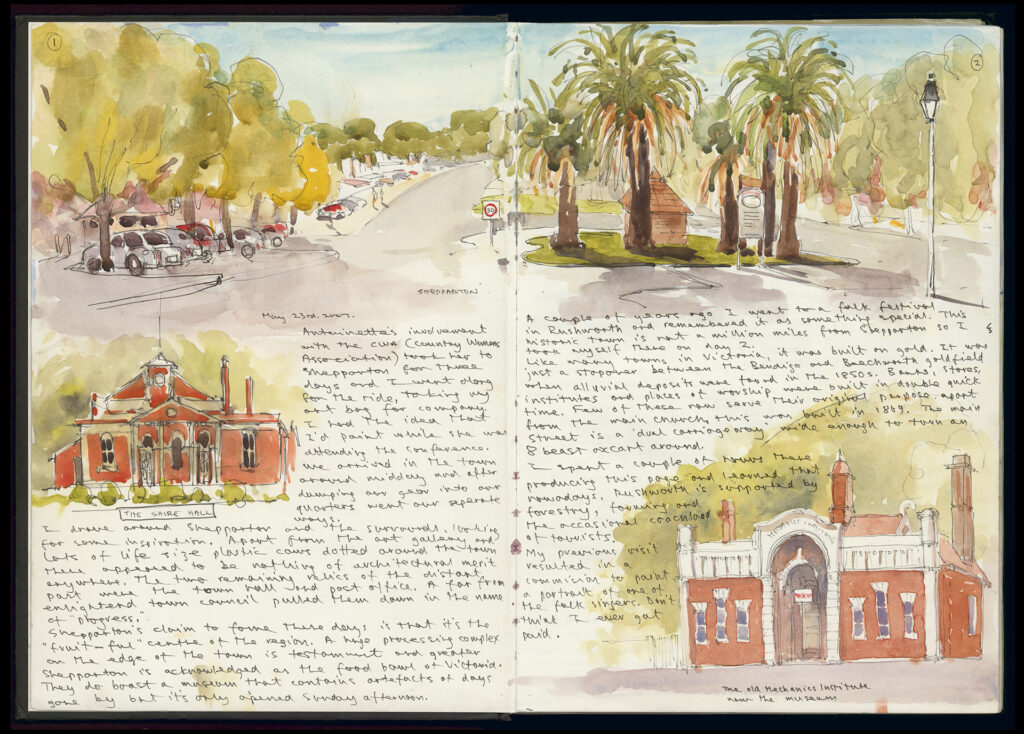

Pages from one of Brian Pleasants’ Illustrated Diaries, dated from 2007-2012.
Travel artwork continues to thrive today, not just as a means to document locations but as a way to capture experiences and emotions. It reminds us that, alongside the visual records created by photographs, drawing or painting can provide a distinct avenue to reveal personal perspectives and the emotions tied to the journey. Our NZMS team in Te Whanganui-a-Tara Wellington recently had the privilege of digitising 9 illustrated diaries for the family of artist Brian Pleasants.
These diaries paint a vivid picture of the adventures Brian and his wife, Antionette, embarked on together. Beautifully illustrated, they are filled with fascinating tales and experiences from across the globe. We recently spoke with Brian’s son, Simon, about his father’s diaries and the significance of their digitisation.
Art, Technology, and Travel
While growing up in the UK, Brian Pleasants harboured a strong interest in art, a talent nurtured by winning a scholarship to the Norwich School of Art at age 14, where he started working towards the National Diploma in Arts. However, his journey toward becoming an artist was paused due to conscription into the Royal Air Force for the UK National Service.
Following his time in the RAF, Brian received technical training and moved into the electronics field, securing a role at IBM. He specialised in large mainframe computers (that often occupied entire rooms!), which served as powerhouses for number crunching and data analytics. These computers were frequently utilised by government institutions and universities.
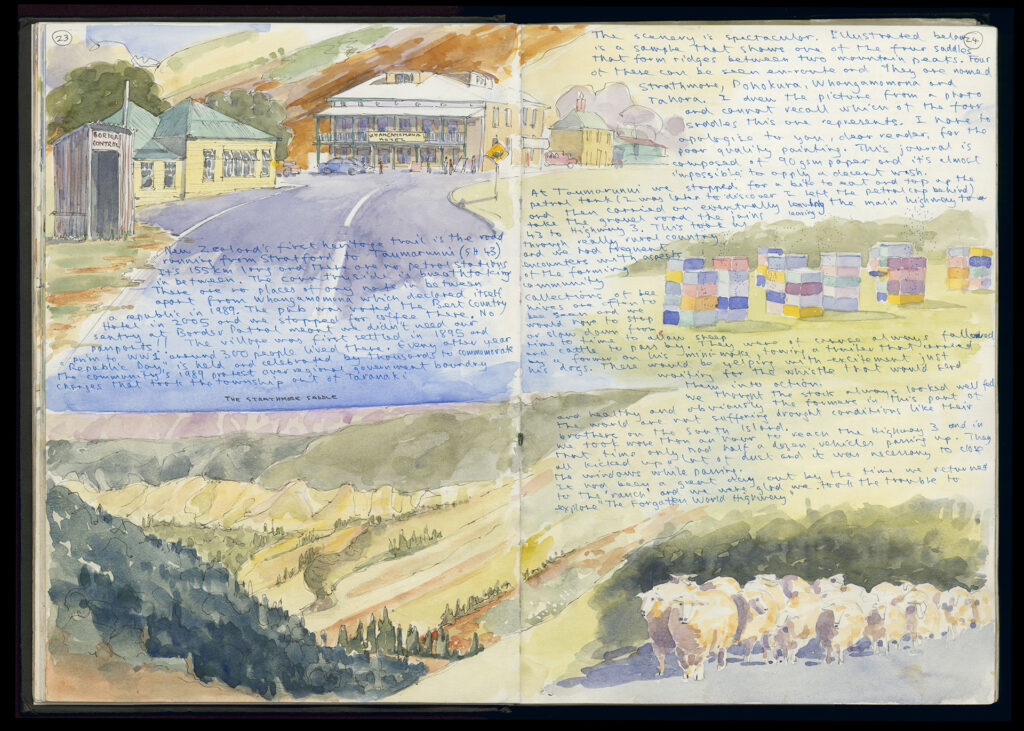
Brian’s passion for art was rekindled in the 1970s after he was gifted a set of oil paints. This renewed interest led Brian to convert the attic of his home into a dedicated studio, and it marked the beginning of a very productive phase in his career as an artist. He described his style as “rugged reality,” influenced by artists he admired, such as Maxwell Wilks and Herman Pekel.
His position at IBM often took him overseas, to cities like Johannesburg and Helsinki, where he used his free time to capture the local scenes through his art. Eventually, he began to become more interested in using watercolour paints, largely due to their practicality and ease of use while travelling.
“He was an exuberant man who lived a happy life – and the diaries are evidence of that. They are very important taonga for our whole family. They’re very engaging, you can lose yourself in them a little bit.”
Simon Pleasants
Words and Watercolours
The beginnings of the illustrated diaries coincided with a series of holidays that Brian and his wife Antoinette began taking after their children had grown up and set out on their own paths. On these travels, Antoinette would spend her spare time reading and journaling, while Brian painted landscapes and local scenery. It was during a Mediterranean getaway that Brian decided to illustrate one of Antoinette’s journal entries, a move that sparked a joint venture to record future trips together – using her stories and his sketches.
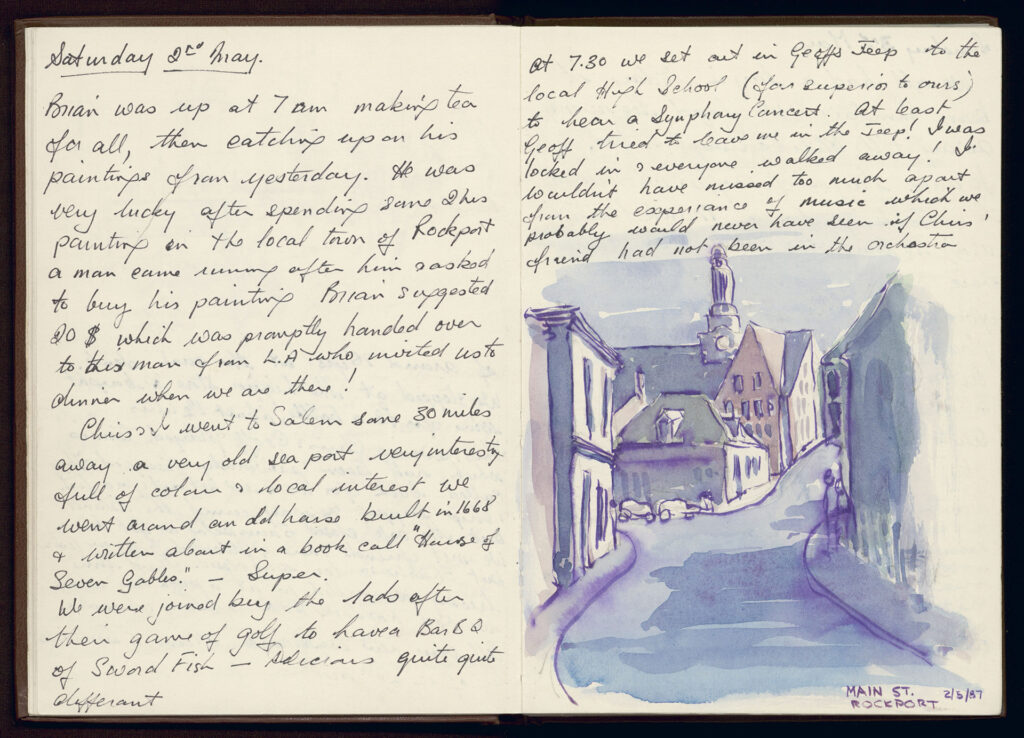
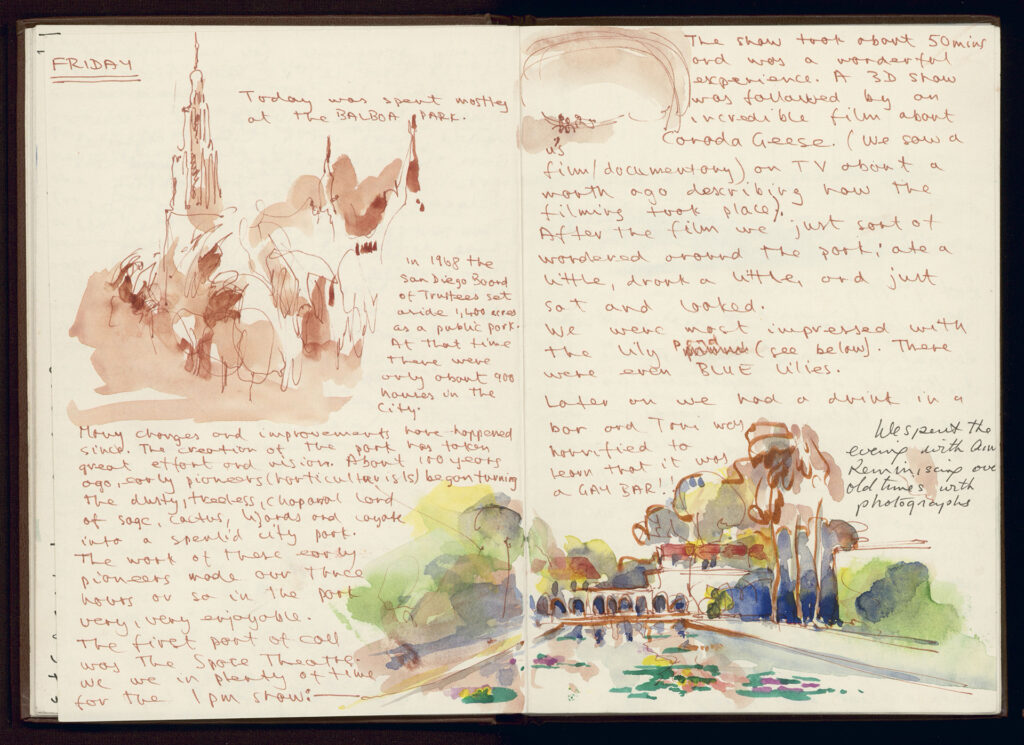
Pages from the first of Brian Pleasants’ Illustrated Diaries, dated 1987.
The first illustrated diary came to life in May 1986. As time went on, Brian started handling both the writing and the artwork – aiming to speed up the process while seamlessly blending the elements on each page. This ensured Brian could capture impressions while they were still fresh in his mind, while also enriching the interplay between the descriptions and their associated sketches.
“Many of the diaries feature overseas destinations, though he also frequently highlighted England, where my parents lived for most of their lives. They moved to Sydney around 1997, mainly because my brother and I were residing there at the time. They ended up doing a lot of travelling around Australia and New Zealand.”
Simon Pleasants
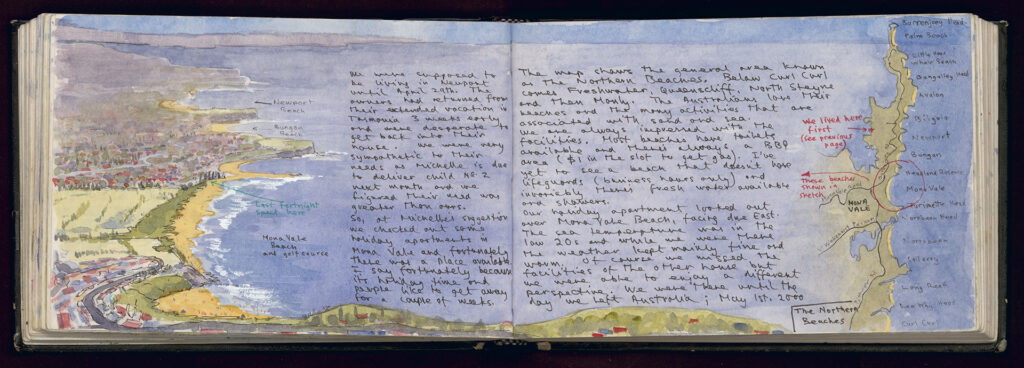
Brian would spend a lot of time preparing to write and illustrate each new entry, ensuring that they contained accurate and well-researched details that supported his observations. He gathered information from a variety of sources, including guidebooks, internet searches, maps, and conversations with locals. One lesson that Brian learnt while creating the diaries was the importance of timely completion. Delaying an entry made it challenging to capture his experiences vividly, which encouraged him to document each day’s events that same evening. This routine made sure he could start anew the next day with a clean slate.
“My mother deserves an honourable mention. My dad’s commitment to painting, a hobby that demanded precision and produced high-quality work, meant that some dinners and evenings out were sacrificed. For example, sometimes he’d choose to stay in the hotel room to complete his artwork instead of going out to a restaurant. She certainly deserves a medal in terms of the tolerance and patience that she displayed because he would sometimes get quite obsessive over his painting.”
Simon Pleasants
Compiling an Travel Art Kit
To create the diaries while travelling, Brian relied on a modest yet effective set of tools, all neatly organised in an easy-to-carry and compact black zippered bag. Central to his kit was a Winsor & Newton paintbox, which was filled with a selection of primary colours and a couple of more vibrant, unusual hues. When it came to brushes, he preferred using Art Spectrum’s Sablinsky line known for their quality and durability. He also carried a selection of pigment liners that could produce fine lines to complement and define his watercolour paintings. One of Brian’s favourite sketchbooks to use for the diaries was those produced by Daler Rowney featuring thick, 150g/m² acid-free cartridge paper. The quality of the paper was important as it needed to withstand moisture from the watercolours and the rigours of travel.

“My Dad was very particular about the quality of the paper that he bought. Each diary had to be a particular weight of very good watercolour paper – he was very fussy about that. He’d travel around with a small watercolour palette. It was about the size of a packet of cigarettes which folded out and included a little water bottle.”
Simon Pleasants
Brian also showcased his inventive side by crafting “Brian’s Belly Board,” a custom-made sketching board designed for situations where traditional setups were impractical. This board allowed for rapid, on-the-spot sketches, supported by hand at the top, with a hook at the lower edge to attach to a belt, preventing slippage. It was lightweight and compact, folding down to a manageable size of 500 x 275mm.
An Evolving Style
The diaries reveal Brian’s artistic development and the evolution of his style over the years. Initially, his illustrations display a more restrained and careful approach, but as time progresses, they begin to embody a freer sense of movement as well as a richer palette of colours. Brian’s attention to the way each page is set out also becomes more apparent in the later diaries; e.g., he would focus on planning out each composition and decide the best way to incorporate the text and imagery.
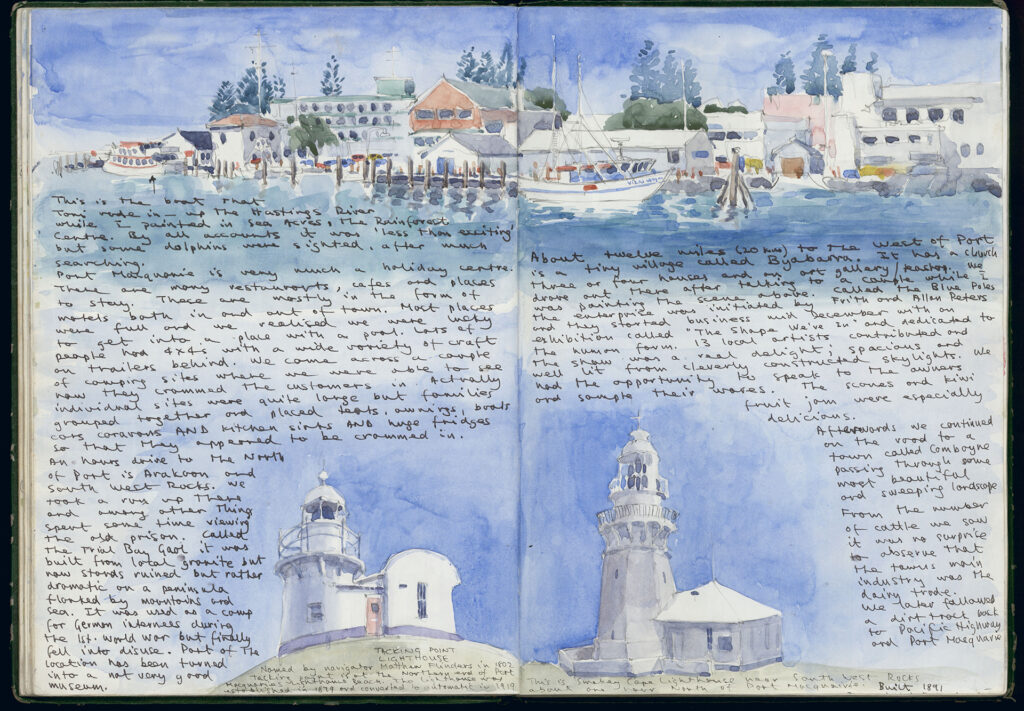
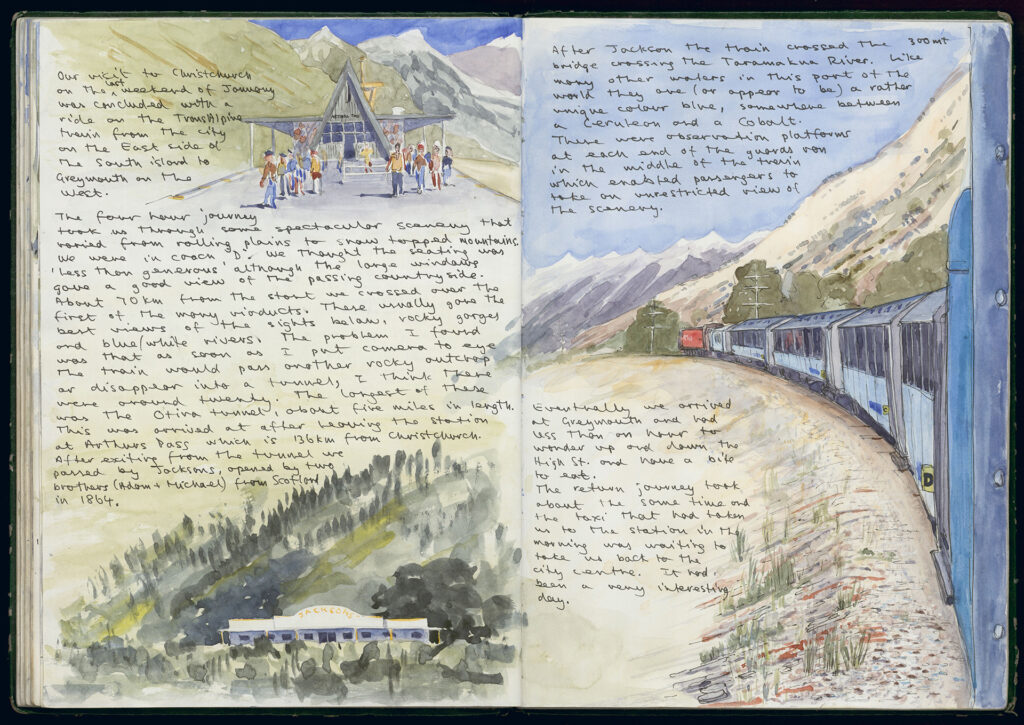
Pages from one of Brian Pleasants’ Illustrated Diaries, dated from 1992-2007
“Sometimes he’d paint en plein air, while other times he would take a photograph to paint later in the hotel room. On occasion, he would also create illustrations based on a postcard he bought that featured a nice scene. He became very careful about planning how each entry would appear on the page. As time goes the diaries become better composed. He might have seen a vista and decided, ‘Oh it’s going travel across two pages and the sky will just fade into the background, leaving me space for the writing.'”
Simon Pleasants
Beyond the pages of his diaries, Brian’s commitment to painting also extended to creating standalone artworks while travelling. He also sometimes used the drawings in his diaries to develop larger, more detailed paintings which he exhibited or sold.
“He’d often venture out alone to paint, setting up with a chair and his watercolour materials in highly touristy spots. American tourists frequently walked by, and my Dad would regale them with tales of being a former chief executive at IBM Europe or similar. This piqued their interest in his artwork, and he’d suggest, ‘Come back later and pay me what you think it’s worth.’ When the tourist returned, they often offer much more for the artwork than its actual value, exceeding what he might earn in a gallery. He was quite mischievous in that manner… yet this approach always left the buyers with a memorable story to tell their friends about owning an artwork crafted by a supposed former IBM chief executive!”
Simon Pleasants
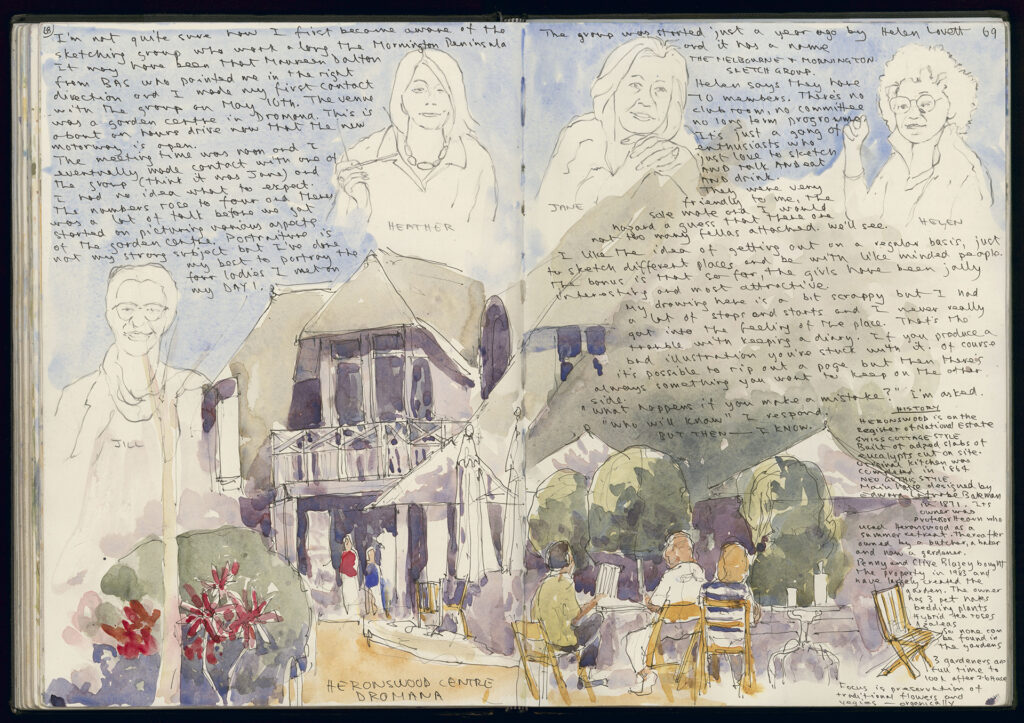
As Brian discovered, creating art while travelling can offer a unique avenue for connecting with people, from locals to fellow travellers. Conversations initiated over a sketchbook could lead to valuable insights, from local recommendations to unexpected invitations.
Digitising Family Memories
The diaries are deeply valued as taonga within the Pleasants family, encapsulating years of important events and memorable places visited by Brian and Antoinette. Acknowledging their significance, Brian stipulated in his will that a diary would be given to each of his five grandchildren and one each to his sons (Simon and Stephen) ensuring the stories they hold can be shared across generations. Before digitisation, the family carefully labelled each diary, naming them after the specific events or milestones they chronicle.
“There are entries there that record Mum and Dad first meeting their grandchildren and some that describe the various holidays that they had with us. I think the value has always been in the treasured memories, leafing through the books and discovering, ‘Oh, I haven’t seen that before.’ Discovering new things or some mischievous insight that Dad’s noted down. Some of it is, ‘We went here, we went there, and we saw these people.’ In one entry he became fascinated with a metal worker in an Australian outback town, managed to learn their name, and even conducted a brief interview with them. I always found those sorts of entries quite good because he was such a people person.”
Simon Pleasants
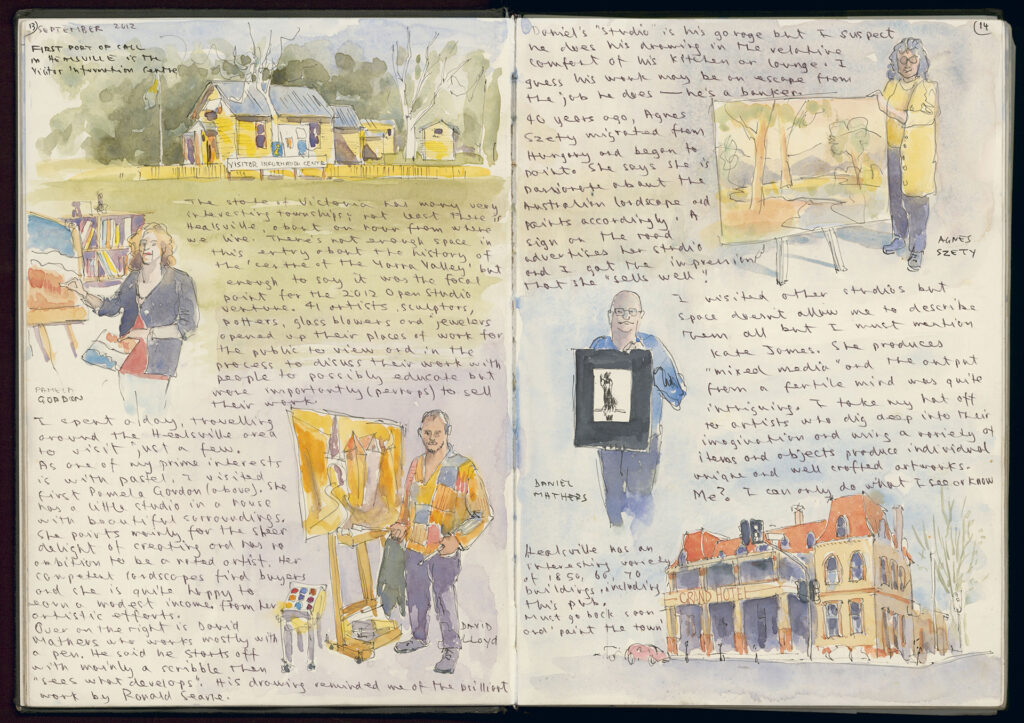
NZMS approached this project with the utmost care, using our high-resolution scanners to ensure that the intricate details, such as brushstrokes, and vibrant colours found in Brian’s illustrations were preserved. This attention to detail ensures that a replica can be printed from the digital images, one which retains the integrity of the original diaries. Printing physical replicas from the digital files was driven by the wish to bring these memories into the hands of each family member, allowing them to hold and browse the entire collection in their own homes.
“Even though we all receive one of the diaries, the reason I pursued digitisation was because they are taonga together as well as apart. It is a collection. I thought there was only one time when all the diaries are going to be together, so I better get them digitised so we can make replicas and all of them can be available to everyone. You know when you’re looking through a hard copy book it is different, the experience is different. You come across things that you wouldn’t if you were just looking at them on a screen.”
Simon Pleasants
In entrusting NZMS with the digitisation, the Pleasants family sought not just our technical expertise but also our understanding of the deep sentimental value of the diaries. Our team gladly gave Simon a thorough tour of our Wellington facilities, ensuring he felt confident in the safety and security of his father’s diaries. With the digitisation now complete, the task remains for Simon to distribute the diaries to the family members in Australia.
“I didn’t want to send them by mail somewhere. I wanted to be able to see the people and check out the place. I came to NZMS originally because my very good friend at the National Archives recommended you. I take personal recommendations seriously and my friend really knows what he’s talking about. He’d only recommend somebody that he trusted!”
Simon Pleasants
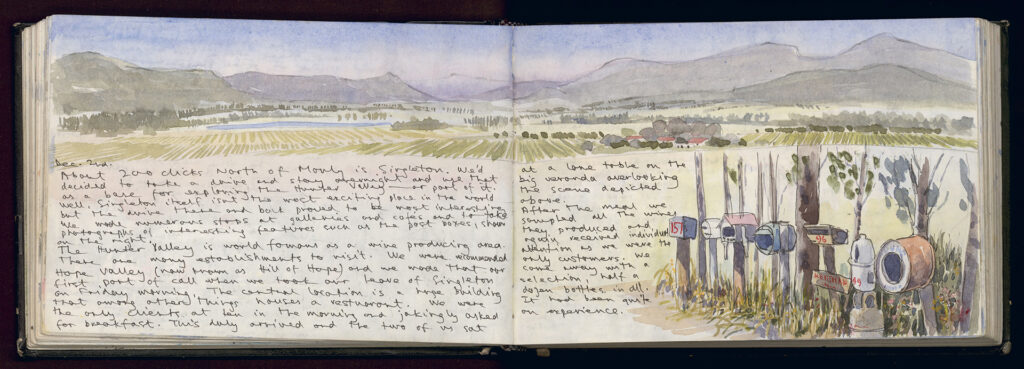
When asked what advice he’d give to others looking to digitise their family taonga, Simon said:
“When someone passes away, deceased estates get spread around. There’s often a value in the curatedness of things all being together. If that’s a practical thing I would recommend it. I would also say that digitisation is a kind of insurance against physical damage, e.g., fire, flood, or whatever. Also, as items get distributed there’s a risk that people lose them, so it’s good for everyone to still have access to the whole collection.”
Simon Pleasants
References:
- Davey, L. (2005, October 6). The concept of travel in art through the ages. Wanderarti. https://www.wanderarti.com/the-concept-of-travel-in-art-through-the-ages/
- Pleasants, B. (2012, June). Travelogues: A companionable art form. Australian Artists, 336, 58–63.
- Pleasants, B. (2017, June 29). About. Brian Pleasants. https://brianpleasants.wordpress.com/about/
- Rardon, C. (2014, May 15). Travel Sketching: a manifesto. National Geographic. https://www.nationalgeographic.com/travel/article/travel-sketching-a-manifesto
